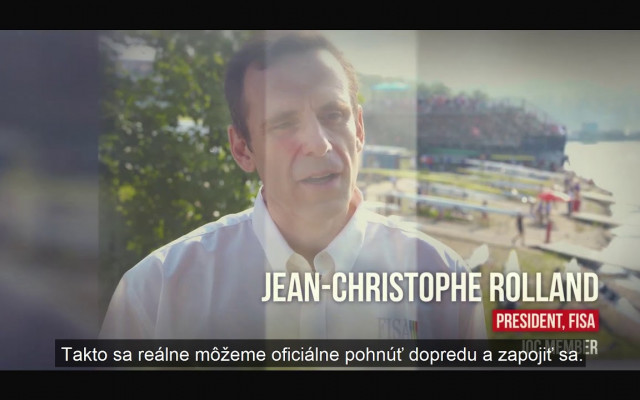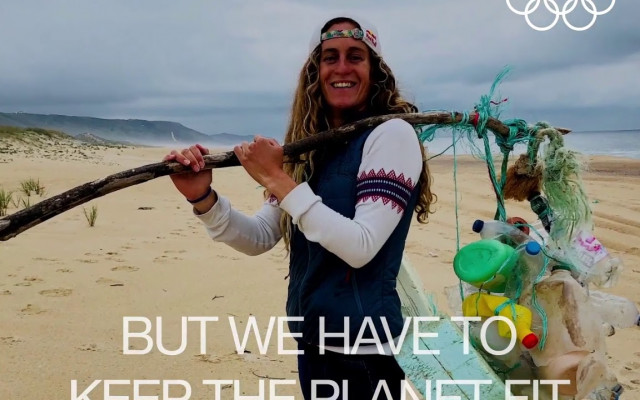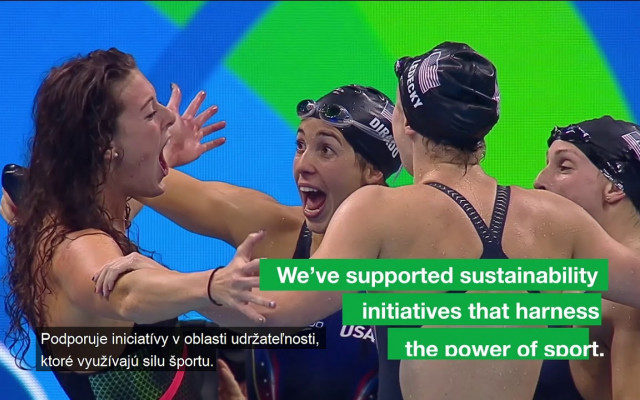READY TO BE ECO
TEN GREEN RECOMMENDATIONS PREPARED BY ECOWORKSHOP STUDENTS FOR EYOF BANSKÁ BYSTRICA 2022
ENJOY NATURE BY WALKING, CAR-SHARING, SHUTTLE OR PUBLIC TRANSPORT INSTEAD OF USING A PRIVATE CAR
Transport accounts for about 64% of global oil consumption, 27% of all energy use and 23% of the world's energy-related CO2 emissions.
#GoGreen #GreenTransport
WATER DOESN´T NEED TRAINING. GIVE IT A BREAK.
While washing your teeth with the water on, you waste 18 litres of water.
#GreenIsWin #SaveWater
BE A MODERN VAMPIRE. BECOME A SUSTAINABLE VEGAN. YOU CAN BE THE ONE. CHOOSE THE GOOD ONE.
Eating a vegan diet can reduce your carbon footprint by 73%.
#GoGreen #EmissionsReduction
PLUG OUT ALL OF THE UNNECESSARY ELECTRIC DEVICES. GIVE THEM A REST.
Stand by mode is responsible for 1% of worldwide CO2 emissions.
#RunTheChange #SaveEnergy
IF YOU ARE SO GOOD AT SPORTS, TRY TO BE THAT GOOD AT QUICK SHOWERING.
1 minute shower = 9 litres of water
#GoGreen #SaveWater
DON´T BE A PUNK, AND RECYCLE YOUR JUNK.
Every year we dump a massive 2 billions tons of waste.
#ScoreGreen #WasteSorting
TRY TO DO SOMETHING DRASTIC, AND CUT THE PLASTIC!
1500 plastic bottles are thrown away every SECOND.
#GoGreen #PlasticReduction
USE YOUR OWN BOTTLE, MAY IT BECOME YOUR BEST FRIEND TOO. DRINK TAP WATER!
Consumers around the world purchase 1 million plastic bottles every MINUTE.
#RunTheChange #ReducePlastic
IT IS ALWAYS BETTER TO TURN AROUND TWICE THAN THROW IT ALL AT ONCE. DON´T WASTE FOOD!
Around the world, we waste 41 tons of food every SECOND.
#GreenIsWin #DontWasteFood
TURN OFF THE LIGHT, WHEN IT IS BRIGHT, LIKE ON A TENNIS COURT AT NOON.
We spend 10% of our electricity bills on lighting.
#GoGreen #SaveEnergy
Why do we address climate protection in sport?
“Each one of us can make a difference.
Together we make a change.”
(Barbara Mikulski)
Global warming is one of the most serious problems facing humanity. Climate change and its impacts will affect current and future generations more and more, with disastrous consequences. The planet does not need us, but we are unfortunately unable to survive without it - it gives us oxygen, water, and food.
People are depleting resources to such an extent that the ecosystem is no longer able to cope with this long-term pressure. The planet works much like the human body. For example, in sports it is able to handle a certain load. However, in the case of long-term overloading the body collapses. Something similar is happening all around us. Weather fluctuations, floods, hurricanes, and melting glaciers are just the beginning. Rapid loss of drinking water as well as a lack of fertile land (with subsequent food shortages) are the main consequences we will face in the coming years.
Today, around 12,000 people die every day from polluted outdoor air. Rising temperatures sounds trifling, but imagine if your body temperature jumped by 3 degrees Celsius… could the human body handle it? For a while, yes, but you wouldn't survive for long. Likewise the ecosystem of our planet has its limits, and humanity will pay for their failure to protect it. If each of us made at least small changes in our daily habits, the reality of 20 years from now may look completely different. It just needs discipline and a desire for change.
Ekoworkshop students prepared a set of 10 green recommendations for EYOF Banská Bystrica 2022. Adherence to them will save natural resources - water, food, and energy. We present a few interesting facts that may motivate them to comply even more.

WATER
Do you know how much water we consume per day? You are probably consuming a lot more water than you think. The water you use for drinking, cooking, showering, etc., is only a tiny fraction of the water we actually use. Water is the "blood" that flows through the veins of the earth. It is the basis of everything living around us. We use water all over the world. It provides us with food, clothing, electronics, etc.
So what is our actual water consumption?
Daily freshwater consumption per person is 3,800 litres (indirect consumption, global average). Most of this water (more than 90%) is used as "virtual water" through the products we buy. This hidden commodity represents one of the largest trade flows in the world. Water is needed in the production of almost all products.
About 1.7 trillion tons of water are traded every year. By comparison, the next most traded product in the world is oil. The world consumes about 100 million barrels of oil per day, equivalent to 11.9 million tons per day or 4.3 billion tons per year. This means that measured in tonnes, the global trade in virtual water is 400 times greater than the second most traded commodity in the world - oil.
If you want to help protect water, get involved:
Take a short shower. Capture rainwater where you can. Use gentle cleaning agents to avoid contaminating groundwater. Try to monitor the products you buy and support those companies that take responsibility for water consumption.
Water recycling also plays an important role! For example, aluminium products made from recycled aluminium consume only 17% of the water needed to produce the same product from new aluminium. Or save 1 ton of recycled paper for more than 20,000 litres of water (plus about 17 trees).
On average, each of us uses 150 litres of water per day (direct consumption - drinking, hygiene, washing, cooking, etc.). One person consumes more than 54,000 litres of water per year through direct consumption, but uses an average of more than 1.4 million litres per year through indirect consumption (i.e. virtual water). Clean and drinkable water is not to be taken for granted. One minute of showering = 9 litres of water consumed 9 litres during the shower = drinking water for 3 people for one day

WASTE
Did you know that households around the world produce 60 tons of household waste per second? We discard more than 2 billion tons of domestic waste a year worldwide. Every 2 hours we throw away enough to fill the world's largest container ship with waste. That's 12 container ships every day, so 4570 per year. With the world's growing population, waste production is also increasing. By 2050, household waste will have increased by 70% to 3.4 billion tonnes per year, meaning waste production will be more than double the equivalent population growth. That is, if we do not change!
What we are actually seeing is just the tip of the iceberg. We only see a tiny fraction of the waste that is actually generated by daily human consumption.
1 bag = 70 bags
What does it mean? Each bag of household waste produced approximately 70 bags of waste during the mining and production process. In order to be able to imagine what this means in practice, we present an example of waste generation behind our products:
Steel: Every product requires energy to be made, from the mining process and production, to distribution and consumption. For example, steel is used in a factory to process your food products, to mine aluminium for your can of flavoured beverage, and for the truck that brought the products to the store. 1 kilogram of steel produces 80 litres of wastewater.
Where does our household waste go?
Most waste goes to landfills or is incinerated. Waste incineration is the main cause of dioxins around the world, which are one of the most toxic chemicals known to man. Waste incineration therefore contributes to air pollution problems. Waste production and incineration is also a key factor in causing global warming, and in 2016, accounted for about 5% of external emissions. By 2050, this number will increase by more than 60% unless serious measures are taken.
How can the waste problem be solved?
PThe first, basic rule is waste prevention. What I mean by this is, we don't buy things unless we really need them. When we don't create waste, we don't have to bother sorting it. If we already have it, do we know what we're throwing away? The fact remains that, according to surveys, 70-80% of the total amount of waste produced can be reused or recycled.
STherefore, we want to generate a minimum of mixed municipal waste. In order to achieve this, we follow 5 rules, the so-called 5R model (you can find more about the 5R model here: https://www.zembezodpadkov.sk). The 5R model (from English REFUSE, REDUCE, REUSE, RECYCLE, ROT) helps us prevent waste in everyday life.
Source: https://www.theworldcounts.com/challenges/planet-earth/waste/waste-from-households/story https://www.zembezodpadkov.sk
ENERGY
Annual global energy consumption is estimated at 580 million terajoules, which has increased by about a third since 2000 and is expected to have increased by a further 30% by 2040. From 2000 to 2040, this will represent a 77% increase in global energy consumption. To illustrate, the world's annual energy consumption corresponds to the energy released from the Hiroshima nuclear bomb every four seconds. The Boeing 737 can cross the Atlantic Ocean for one terajoule.
83% of the energy we use comes from fossil fuels. Oil is the largest source of energy, followed by coal and natural gas. Green energy innovation is therefore absolutely essential. So far, most of the increase in global energy consumption has been covered by burning more coal and gas. That is not good. It emits a huge amount of CO2 into the atmosphere. The world must completely change the global energy system.
Solar energy could power the world, easily. In 6 months, the Earth absorbs the same amount of energy from the Sun as it would obtain from all non-renewable resources (coal, oil, natural gas and uranium) including non-renewables that have not yet been used! In less than 80 minutes, the Earth is hit by solar energy equivalent to the world's total energy consumption, which means that the Sun could power the world almost 7,000 times. In 2019, approximately 11% of the world's primary energy came from renewable technologies.
How can you help?
Until we are able to fully exploit and get this energy into the system, try to take into account the unnecessary consumption you generate. The standby mode of appliances / chargers is responsible for 1% of the world‘s CO2 emissions. If you use devices / chargers, remove them from the plug socket after use. Switch off the light if you don‘t really need it. Instead of drying laundry in the dryer, use a hanger. Use the stairs instead of the elevator; in addition to the energy saved, you will strengthen your condition and therefore your health.
Source: https://www.theworldcounts.com/challenges/climate-change/energy/global-energy-consumption/story
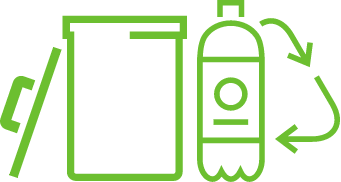
FOOD WASTE
Food waste is a global problem that has a significant negative impact on our environment. Along with uneaten food, rare natural resources such as water, soil, energy, and labour which are consumed in cultivation, processing and distribution, "end up in the basket". The carbon footprint of food waste is up to 3.5 billion tons of CO2, which is 8% of total world greenhouse gas production. Only China and the US have a larger carbon footprint than global food waste. As much as 28% of agricultural land (1.4 billion hectares) is used to grow food that ends up as waste. It is an area equal to the area of China, Mongolia and Kazakhstan put together.
The volume of water used is 250 cubic kilometres, which is the annual flow of the Volga River and more than the total annual water consumption in Indonesia (only the USA, China, and India are ahead of it).
Discarded food is also a direct financial loss for producers, traders, and consumers. In 2014, the FAO estimated the direct economic damage associated with waste at an incredible $ 936 billion. However, this is just the tip of the iceberg. Costs related to land grabbing and erosion, biodiversity loss, air pollution, water degradation, loss of housing, damage to health, and compensation for these losses must also be added to the total bill for the production of food that will never be eaten. According to the FAO analysis, the total food waste bill is up to $ 2.6 trillion, which is the value of France's gross domestic product.
Food waste is also an ethical and moral problem. While one in nine people in the world suffers from malnutrition or hunger because of limited access to food and nutrition, we would be able to feed all the hungry people in the world, up to four times, out of the current amount of food waste. The World Health Organization also states that in 2016 up to 1.9 billion people were obese or overweight. These figures demonstrate that the current set-up of the global food system is unfair and discriminates against the most vulnerable.
As many as 9% of households throw away food on a daily basis. Fruit and vegetables, bread and pastries as well as cooked food and dairy products often end up as waste.
The main cause of waste is that we buy more food than we can consume and we cannot store it properly. At least a third of Slovaks cannot say for sure what the difference is between the expiration date and the date of minimum durability.
How can you get involved?
Try to buy only as much food as you can consume. Put only enough on your plate so that you don't throw any away. Worldwide up to 41 tons of food are thrown away every second.
Waste in numbers
Food is wasted across the supply chain in every single country, from initial agricultural production to final consumption in the home
Ending up in the trash:
- 30% of all cereals
- 20% of all dairy products
- 45% of all fruits and vegetables
- 20% of all oilseeds and legumes
- 35% of all fish and seafood
- 45% of all root vegetables and tubers
- 20% of all meat
The main causes of waste include:
- overproduction
- crop losses
- poor crop storage
- incorrect transport
- packaging errors
- high aesthetic standards for fruits and vegetables
- buying too much inventory
- disproportionately large portions in mass catering
- bad consumer habits
- improper storage of food by households
Source: (OZ Free Food, 2021), OZ Free Food (2021), www.free-food.sk/problem/ake-su-statistiky/
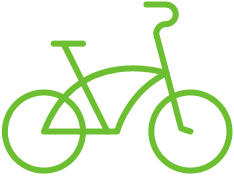
TRANSPORT
Take children to school, go shopping, or go to work or school daily. That is enough, so there is no need to take the choice of means of transport lightly. Two wheels are better than four and traveling by train is the right choice for longer distances. Transport is one of the main sources of total greenhouse gas emissions, representing approximately 12% of the total.
Transport is one of the most serious threats to urban health. The UN identifies air pollution as the biggest environmental health risk in the world. Every day we inhale extremely small toxic particles that can cause asthma, lung cancer, and heart problems. Some of them are so small that they can enter the bloodstream.
93% detí na svete dýcha toxický vzduch každý deň. To je viac ako 1,8 miliardy detí na celom svete. WHO odhaduje, že 600 000 detí ročne zomiera na infekcie dýchacích ciest spôsobené znečistením ovzdušia.
Ako sa môžete zapojiť?
Práve tu môže zavážiť rozhodnutie jednotlivca, aký spôsob dopravy využijete. Pri krátkych vzdialenostiach netreba rozmýšľať - ísť peši alebo na bicykli je najvhodnejšie. V rámci diaľkovej dopravy je najefektívnejší vlak. Ak už musíte šoférovať, zvážte, či sa s vami môže zviesť aj nejaký kolega či známy.
93% of children in the world breathe toxic air every day. That's more than 1.8 billion children worldwide. The WHO estimates that 600,000 children die each year from respiratory infections caused by air pollution.
How can you get involved?
This is where an individual can decide which mode of transportation to use. There is no need to think about it for short distances - walking or cycling is best. For long-distance transport, the train is the most efficient. If you already have to drive, consider whether a colleague or acquaintance can join you.
In addition, adding more exercise to your daily routine will improve your ability to concentrate and learn. Various research has shown that physical activity is beneficial for learning and contributes to a calmer atmosphere at school or work. By increasing movement (walking to school, for example), you can improve not only the health and well-being of students, but also improve your learning outcomes.
Source: https://www.theworldcounts.com/challenges/planet-earth/air/air-pollution-deaths-per-year/story Georgina Wilson-Powell: Žijeme zodpovedne https://schoolsonthemove.fi/concept/
EYOF Banská Bystrica 2022 is a big international event. Today green measures should absolutely be a part of all events, not just sports. By following the ‘green ten’ you will help save the natural resources of our planet, but an even more important step is to promote them among your loved ones, or to schools and groups. Awareness of climate change and environmental protection is essential. To change, you need to know the facts because awareness brings interest and interest brings change.
“What you do makes a difference, and you have to decide what kind of difference you want to make.”
(Jane Goodall)




